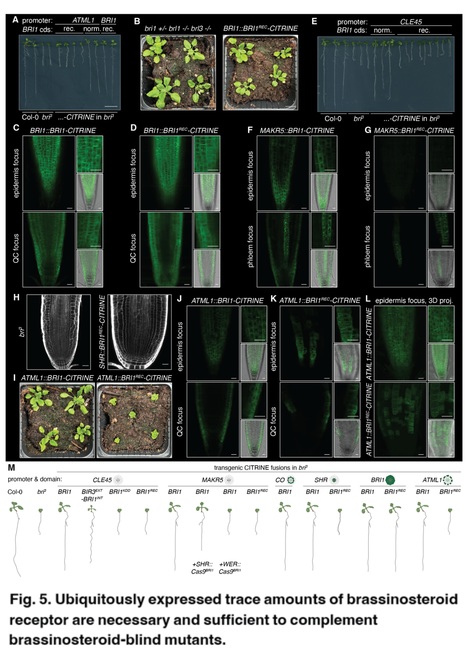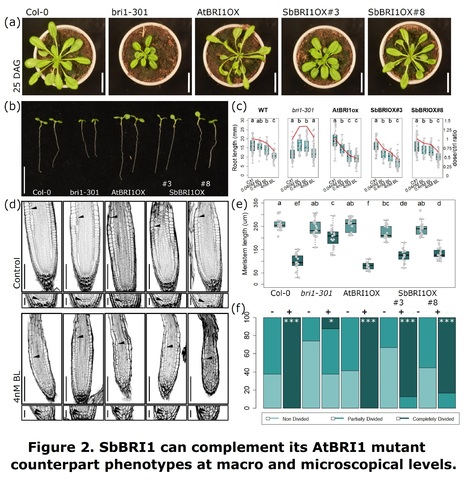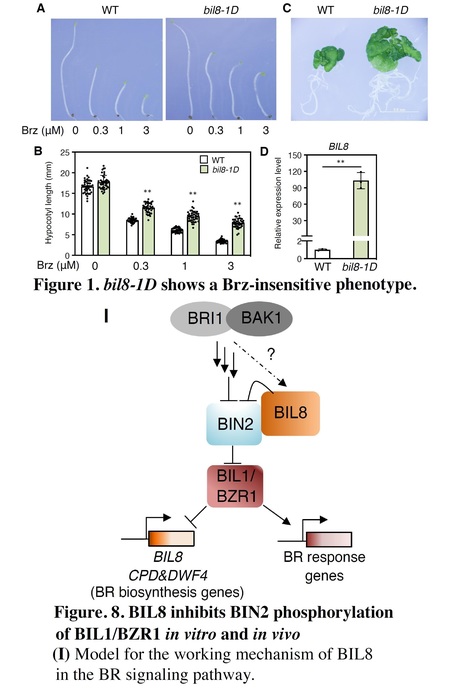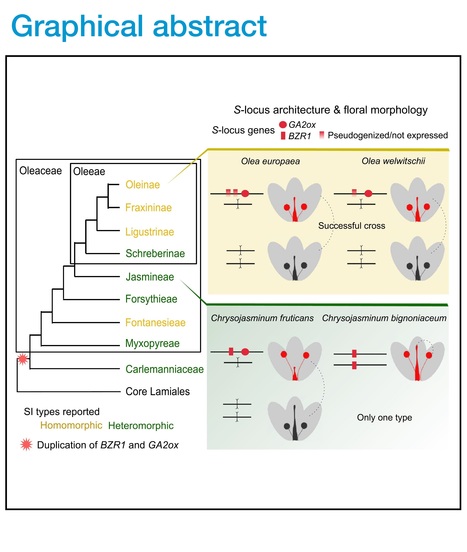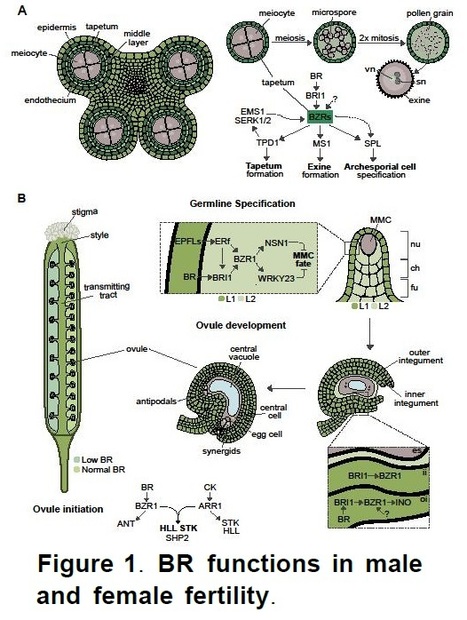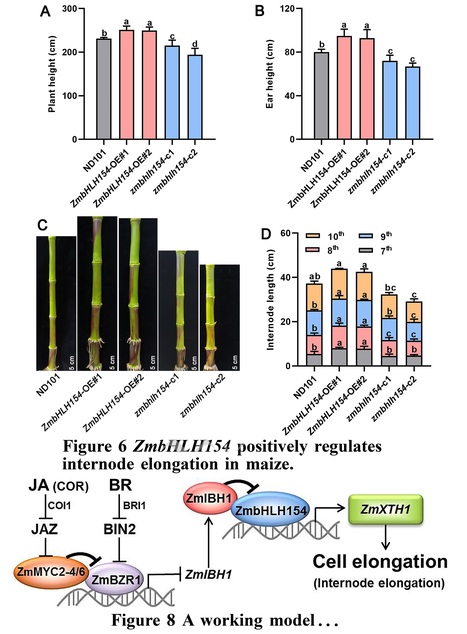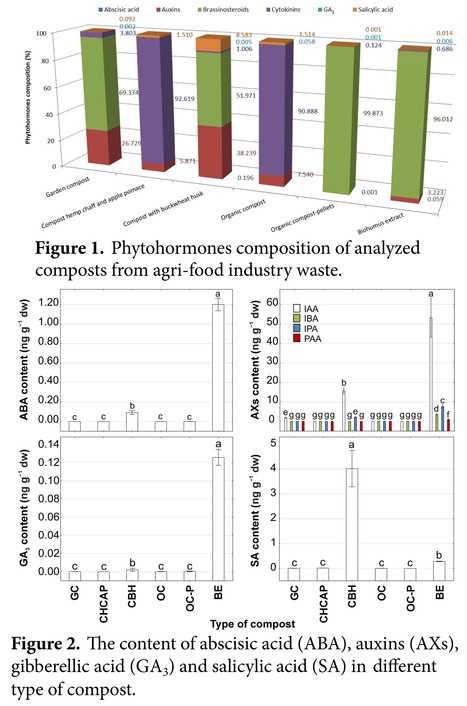 Your new post is loading...
 Your new post is loading...
Authors: Noel Blanco-Touriñán, Surbhi Rana, Trevor M. Nolan, Kunkun Li, Nemanja Vukašinović, Che-Wei Hsu, Eugenia Russinova and Christian S. Hardtke.
bioRxiv (2024)
Abstract: "Brassinosteroid signaling is essential for plant growth as exemplified by the dwarf phenotype of loss-of-function mutants in BRASSINOSTEROID INSENSITIVE 1 (BRI1), a ubiquitously expressed Arabidopsis brassinosteroid receptor gene. Complementation of brassinosteroid-blind receptor mutants by BRI1 expression with various tissue-specific promoters implied that local brassinosteroid signaling may instruct growth non-cell-autonomously. Here we performed such rescues with a panel of receptor variants and promoters, in combination with tissue-specific transgene knockouts. Our experiments demonstrate that brassinosteroid receptor expression in several tissues is necessary but not sufficient for rescue. Moreover, complementation with tissue-specific promoters requires the genuine BRI1 gene body sequence, which confers ubiquitous expression of trace receptor amounts that are sufficient to promote brassinosteroid-dependent root growth. Our data, therefore, argue for a largely cell-autonomous action of brassinosteroid receptors."
Authors: Diego Alejandro Gutiérrez-Villamil, Stanislav Magnitskiy and Helber Enrique Balaguera-López.
Postharvest Biology and Technology (2024)
Highlights • BR have a potential signaling function in the regulation of fruit development. • BR are a postharvest technology to regulate the ripening of fruits and vegetables. • BR mitigate chilling injury by increasing antioxidant systems. • BR induce expression genes of defense and immunity against postharvest pathogens.
Abstract: "Fresh horticultural products satisfy the nutritional, and industrial needs of consumers worldwide. However, the lack of understanding of the fruit development process, the accelerated senescence process and the lack of post-harvest technology in some regions, present a threat to the food and economic security of the food agribusiness. Brassinosteroids (BR) are plant hormones involved in the regulation of various physiological processes and have recently proven to be a viable post-harvest technology alternative to regulate the ripening and senescence of fruits and vegetables. In this review, the current state of BR research on fruit growth and development, physicochemical changes during ripening, and biotic-abiotic stress during the post-harvest life of horticultural products is presented. Furthermore, the review encompasses the effect of the application of exogenous BR and its relationship with molecular signaling on the processes mentioned above, including aspects such as methods, moments and BR analogues at the time of application, and the molecular mechanisms involved. This review proposes a basis for research of the physiological aspects of BR regulation in fruits and vegetables during their development and post-harvest period, and also points to a direction for in-depth investigation of the molecular mechanisms."
Authors: Amanpreet Kaur, Norman B. Best, Thomas Hartwig, Josh Budka, Rajdeep Khangura, Steven McKenzie, Alejandro Aragón-Raygoza, Josh Strable, Burkhard Schulz and Brian P. Dilkes.
Plant Physiology (2023)
One-sentence summary: Molecular identity of a maize semidwarf mutant reveals a role for the maize GRAS domain transcription factor ortholog of DWARF AND LOW TILLERING in brassinosteroid signaling.
Abstract: "Brassinosteroids (BR) and gibberellins (GA) regulate plant height and leaf angle in maize (Zea mays). Mutants with defects in BR or GA biosynthesis or signaling identify components of these pathways and enhance our knowledge about plant growth and development. In this study, we characterized three recessive mutant alleles of GRAS transcription factor 42 (gras42) in maize, a GRAS transcription factor gene orthologous to the DWARF AND LOW TILLERING (DLT) gene of rice (Oryza sativa). These maize mutants exhibited semi-dwarf stature, shorter and wider leaves, and more upright leaf angle. Transcriptome analysis revealed a role for GRAS42 as a determinant of BR signaling. Analysis of the expression consequences from loss of GRAS42 in the gras42-mu1021149 mutant indicated a weak loss of BR signaling in the mutant, consistent with its previously demonstrated role in BR signaling in rice. Loss of BR signaling was also evident by the enhancement of weak BR biosynthetic mutant alleles in double mutants of nana plant1-1 and gras42-mu1021149. The gras42-mu1021149 mutant had little effect on GA-regulated gene expression, suggesting that GRAS42 is not a regulator of core GA signaling genes in maize. Single cell expression data identified gras42 expressed among cells in the G2/M phase of the cell cycle consistent with its previously demonstrated role in cell cycle gene expression in Arabidopsis (Arabidopsis thaliana). Cis-acting natural variation controlling GRAS42 transcript accumulation was identified by expression genome-wide association study (eGWAS) in maize. Our results demonstrate a conserved role for GRAS42/SCARECROW-LIKE 28 (SCL28)/DLT in BR signaling, clarify the role of this gene in GA signaling, and suggest mechanisms of tillering and leaf angle control by BR."
Authors: Hideki Yoshida and Makoto Matsuoka.
Molecular Plant (2024)
Excerpts: "For example, brassinosteroids (BRs) positively affect plant growth and grain size but negatively regulate the grain number and plant density (Figure 1, top left; Deveshwar et al., 2020; Hwang et al., 2021). Therefore, a thorough understanding of the trade-off functions and regulatory mechanisms of phytohormones is a promising avenue for agricultural improvement."
"Zhang et al. (2024) revealed the molecular regulation of panicle branching by BRs through the cloning and functional analysis of a long-puzzling gene for the clustered spikelet (CL) phenotype. These observations demonstrated that the proper regulation of BR function resulted in higher rice yield."
"Zhang et al. (2024) successfully cloned a causal gene for CL using an elegant genomic analysis with both short- and long-read sequencing techniques. The CL trait is associated with complex structural variations in chromosomes that activate the expression of the BR catabolic gene BRASSINOSTEROID-DEFICIENT DWARF3 (BRD3) in secondary branch meristems."
"Zhang et al. (2024) also showed that introducing the genetic modification of the BRD3 promoter into modern rice varieties resulted in a higher rice yield with a high grain number due to CL and no other defects in field tests."
Authors: Andrés Rico-Medina, David Blasco-Escámez, Juan B. Fontanet-Manzaneque, Natalie Laibach, Fidel Lozano-Elena, Damiano Martignago and Ana I. Caño-Delgado.
bioRxiv (2024)
Abstract: "- The high sequence and structural similarities between BRI1 brassinosteroid receptors of Arabidopsis (AtBRI1) and sorghum (SbBRI1) prompted us to study the functionally conserved roles of BRI in both organisms. - Introducing sorghum SbBRI1 in Arabidopsis bri1 mutants restores defective growth and developmental phenotypes to WT levels. - Sorghum mutants for SbBRI1 receptors show defective BR sensitivity and impaired growth and development throughout the entire sorghum life cycle. Embryonic analysis of sorghum primary roots permit to trace back root growth and development to early stages, revealing the functionally conserved roles of SbBRI1 receptor in BR perception during meristem development. RNA-seq analysis uncovers the downstream regulation of the SbBRI1 pathway in cell wall biogenesis during cell growth. - Together, these results uncover that sorghum SbBRI1 receptor protein play functionally conserved roles in plant growth and development, while encourage the study of BR pathways in sorghum and its implications for improving resilience in cereal crops."
Authors: Zhana Chagan, Genki Nakata, Shin Suzuki, Ayumi Yamagami, Ryo Tachibana, Surina Surina, Shozo Fujioka, Minami Matsui, Tetsuo Kushiro, Takuya Miyakawa, Tadao Asami and Takeshi Nakano.
Plant Physiology (2024)
One-sentence summary: The regulatory factor BIL8 promotes brassinosteroid signaling and plant growth by inhibiting the phosphorylation activity of BIN2 kinase.
Abstract: "Glycogen synthase kinase 3 (GSK3) is an evolutionarily conserved serine/threonine protein kinase in eukaryotes. In plants, the GSK3-like kinase BRASSINOSTEROID-INSENSITIVE 2 (BIN2) functions as a central signaling node through which hormonal and environmental signals are integrated to regulate plant development and stress adaptation. BIN2 plays a major regulatory role in brassinosteroid (BR) signaling and is critical for phosphorylating/inactivating BRASSINAZOLE-RESISTANT 1 (BZR1), also known as BRZ-INSENSITIVE-LONG HYPOCOTYL 1 (BIL1), a master transcription factor of BR signaling, but the detailed regulatory mechanism of BIN2 action has not been fully revealed. In this study, we identified BIL8 as a positive regulator of BR signaling and plant growth in Arabidopsis (Arabidopsis thaliana). Genetic and biochemical analyses showed that BIL8 is downstream of the BR receptor BRASSINOSTEROID-INSENSITIVE 1 (BRI1) and promotes the dephosphorylation of BIL1/BZR1. BIL8 interacts with and inhibits the activity of the BIN2 kinase, leading to the accumulation of dephosphorylated BIL1/BZR1. BIL8 suppresses the cytoplasmic localization of BIL1/BZR1, which is induced via BIN2-mediated phosphorylation. Our study reveals a regulatory factor, BIL8, that positively regulates BR signaling by inhibiting BIN2 activity."
Authors: Pauline Raimondeau, Sayam Ksouda, William Marande, Anne-Laure Fuchs, Hervé Gryta, Anthony Theron, Aurore Puyoou, Julia Dupin, Pierre-Olivier Cheptou, Sonia Vautrin, Sophie Valière, Sophie Manzi, Djamel Baali-Cherif, Jérôme Chave, Pascal-Antoine Christin and Guillaume Besnard.
Current Biology (2024)
Editor's view: Raimondeau et al. unveil the genetic determinants of the unique self-incompatibility system of olives. This initial discovery leads them to identify the genetic controls of distyly within the family and to uncover a genetic overlap between the two systems, rooted in shared ancestry.
Highlights: • Homomorphic self-incompatibility in olives is associated with a hemizygous region • A homologous hemizygous region is also involved in controlling distyly in jasmine • The duplication of this DNA segment is ancestral in the family • Hormonal regulation is central to the production of self-incompatibility phenotypes
Abstract: "Self-incompatibility (SI) has evolved independently multiple times and prevents self-fertilization in hermaphrodite angiosperms. Several groups of Oleaceae such as jasmines exhibit distylous flowers, with two compatibility groups each associated with a specific floral morph.1 Other Oleaceae species in the olive tribe have two compatibility groups without associated morphological variation.2,3,4,5 The genetic basis of both homomorphic and dimorphic SI systems in Oleaceae is unknown. By comparing genomic sequences of three olive subspecies (Olea europaea) belonging to the two compatibility groups, we first locate the genetic determinants of SI within a 700-kb hemizygous region present only in one compatibility group. We then demonstrate that the homologous hemizygous region also controls distyly in jasmine. Phylogenetic analyses support a common origin of both systems, following a segmental genomic duplication in a common ancestor. Examination of the gene content of the hemizygous region in different jasmine and olive species suggests that the mechanisms determining compatibility groups and floral phenotypes (whether homomorphic or dimorphic) in Oleaceae rely on the presence/absence of two genes involved in gibberellin and brassinosteroid regulation."
Authors: Yang Xiang, Guangdong Li, Qian Li, Yingxue Niu, Yitian Pan, Yuan Cheng, Xiangli Bian, Chongyang Zhao, Yuanhong Wang and Aying Zhang.
Journal of Integrative Plant Biology (2024)
Abstract: "Drought stress is a crucial environmental factor that limits plant growth, development, and productivity. Autophagy of misfolded proteins can help alleviate the damage caused in plants experiencing drought. However, the mechanism of autophagy-mediated drought tolerance in plants remains largely unknown. Here, we cloned the gene for a maize (Zea mays) selective autophagy receptor, NEXT TO BRCA1 GENE 1 (ZmNBR1), and identified its role in the response to drought stress. We observed that drought stress increased the accumulation of autophagosomes. RNA sequencing and reverse transcription-quantitative polymerase chain reaction showed that ZmNBR1 is markedly induced by drought stress. ZmNBR1 overexpression enhanced drought tolerance, while its knockdown reduced drought tolerance in maize. Our results established that ZmNBR1 mediates the increase in autophagosomes and autophagic activity under drought stress. ZmNBR1 also affects the expression of genes related to autophagy under drought stress. Moreover, we determined that BRASSINOSTEROID INSENSITIVE 1A (ZmBRI1a), a brassinosteroid receptor of the BRI1-like family, interacts with ZmNBR1. Phenotype analysis showed that ZmBRI1a negatively regulates drought tolerance in maize, and genetic analysis indicated that ZmNBR1 acts upstream of ZmBRI1a in regulating drought tolerance. Furthermore, ZmNBR1 facilitates the autophagic degradation of ZmBRI1a under drought stress. Taken together, our results reveal that ZmNBR1 regulates the expression of autophagy-related genes, thereby increasing autophagic activity and promoting the autophagic degradation of ZmBRI1a under drought stress, thus enhancing drought tolerance in maize. These findings provide new insights into the autophagy degradation of brassinosteroid signaling components by the autophagy receptor NBR1 under drought stress."
Authors: Boyu Guo, Eun-Ji Kim, Yuxian Zhu, Kun Wang and Eugenia Russinova.
Plant and Cell Physiology (2024)
Abstract: "Cellular responses to internal and external stimuli are orchestrated by intricate intracellular signaling pathways. To ensure an efficient and specific information flow, cells employ scaffold proteins as critical signaling organizers. With the ability to bind multiple signaling molecules, scaffold proteins can sequester signaling components within specific subcellular domains or modulate the efficiency of signal transduction. Scaffolds can also tune the output of signaling pathways by serving as regulatory targets. This review focuses on scaffold proteins associated with the plant GLYCOGEN SYNTHASE KINASE3-like kinase, BRASSINOSTEROID-INSENSITIVE2 (BIN2) that serve as a key negative regulator of brassinosteroid (BR) signaling. Here we summarize the current understanding of how scaffold proteins actively shape BR signaling outputs and crosstalk in plant cells via interactions with BIN2."
Authors: Brian Zebosi, Erik Vollbrecht and Norman B. Best.
bioRxiv (2024)
Abstract: "Brassinosteroids (BRs) are important regulators that control myriad aspects of plant growth and development including biotic and abiotic stress responses, such that modulating BR homeostasis and signaling presents enormous opportunities for plant breeding and crop improvement. Enzymes and proteins involved in the biosynthesis and signaling of BRs are well understood from molecular genetics and phenotypic analysis in Arabidopsis thaliana; however, knowledge of molecular function of these genes in other plant species, especially cereal crop plants, is highly limited. In this manuscript, we comprehensively review functional studies of BR genes in Arabidopsis, maize, rice, Setaria, Brachypodium, and soybean to identify conserved and diversified functions across plant species, and to highlight cases where additional research is in order. We performed phylogenetic analysis of gene families known to be involved in biosynthesis and signaling of BRs and re-analyzed publicly available transcriptomic data. Gene trees coupled to expression data provide a useful guide to supplement future research on BRs in these important crop species, such as to allow researchers to identify genes to target through gene editing techniques to perform BR-related functional studies."
Authors: Wenyuan Ruan, Meina Guo and Keke Yi.
Molecular Plant (2024)
Excerpts: "A recent study by Dr. Hong's group (He et al, 2024) has shed new light on the roles of PHRs and SPXs in modulating the trade-off between growth and immunity in response to Pi availability in rice. They elegantly demonstrated that the OsPHR2-OsSPX1/2 module switches JA and BR signaling outputs in response to Pi availability. Under Pi-sufficient conditions, OsSPX1/2 inhibits OsPHR2 from activating JA-mediated defense. Meanwhile, OsBZR1 confers basal resistance by regulating sakuranetin biosynthesis. Under Pi starvation conditions, OsPHR2 dissociates from the OsPHR2-OsSPX1/2 complex and turns on JA signaling and sakuranetin accumulation to suppress Magnaporthe oryzae growth; meanwhile, the released OsSPX1/2 binds to OsBZR1 to suppress BR signaling and plant growth."
"The findings by Hong's group not only highlight the functional diversity of the central Pi signaling regulators but also underscore their crucial role in modulating the trade-off between growth and immunity in plants. These regulators extend beyond their traditional function in Pi signaling and homeostasis, playing a critical role in regulating the interactions between plants and various biotic species, including both harmful and beneficial organisms such as bacteria, fungi, and insects (Figure 1)."
Authors: David Biermann, Michelle von Arx, Kaltra Xhelilaj, David Séré, Martin Stegmann, Sebastian Wolf, Cyril Zipfel and Julien Gronnier.
bioRxiv (2024)
Highlights: -The RALF receptor complex FER-LLG1 regulates cell anisotropic growth -RALF23 promotes BRI1-BAK1 complex formation and signaling -RALF23 functions as a cell wall-informed and wall-modifying signaling cue
Abstract: "Plant cells survey and modulate their cell wall to control their shape and anisotropic growth. Signaling mediated by the plant steroid hormones brassinosteroids (BR) plays a central role in coordinating cell wall status and cell growth, and alterations in the cell wall BR feedback loop leads to life-threatening defects in tissue and cellular integrity. How the status of the cell wall is related to BR signaling remains largely unclear. Increasing evidence shows that RAPID ALKALINIZATION FACTORs (RALFs), a class of secreted peptides, play structural and signaling roles at the cell surface. Here we show that perception of RALF23 promotes the formation and signaling of the main BR receptor complex formed by BRASSINOSTEROID INSENSITIVE 1 (BRI1) and BRI1 BRASSINOSTEROID INSENSITIVE1 BRASSINOSTEROID ASSOCIATED KINASE 1 (BAK1). The loss of the plasma membrane localized RALF receptor complex FERONIA (FER) LORELEI LIKE GPI anchor protein 1 (LLG1) leads to defects in cell expansion and anisotropy, as well as uncontrolled BRI1 BAK1 complex formation and signaling. RALF23 bioactivity relies on pectin status and its perception induces changes in pectin composition and the activity of pectin-modifying enzymes. Our observations suggest a model in which RALF23 functions as a cell wall informed signaling cue initiating a feedback loop that solicits BR signaling, modifies the cell wall, and coordinates cell morphogenesis."
Authors: Wei Ying, Yaowei Wang, Hong Wei, Yongming Luo, Qian Ma, Heyuan Zhu, Hilde Janssens, Nemanja Vukašinović, Miroslav Kvasnica, Johan M. Winne, Yongxiang Gao, Shutang Tan, Jiří Friml, Xin Liu, Eugenia Russinova and Linfeng Sun.
Science (2024)
One-sentence summary: Biochemical, in planta, and structural analyses demonstrate that ABCB19 is a brassinosteroid exporter.
Editor's view: The plant ABC transporter ABCB19 has long been implicated in auxin transport. Ying et al. found an alternative role for ABCB19 as a transporter of another hormone group, brassinosteroids. The authors determined the cryoelectron microscopy structure and found a hydrophobic pocket where brassinolides can bind. They also demonstrated that brassinosteroids triggered ABCB19 ATP hydrolase activity and that mutating specific amino acids in the ABCB19 protein disrupted brassinosteroid transport. The work challenges the auxin-focused view of ABCB19 function and provides an explanation for how brassinosteroids might be exported out of cells to the site of their perception.
Abstract: "Brassinosteroids are steroidal phytohormones that regulate plant development and physiology, including adaptation to environmental stresses. Brassinosteroids are synthesized in the cell interior but bind receptors at the cell surface, necessitating a yet to be identified export mechanism. Here, we show that a member of the ATP-binding cassette (ABC) transporter superfamily, ABCB19, functions as a brassinosteroid exporter. We present its structure in both the substrate-unbound and the brassinosteroid-bound states. Bioactive brassinosteroids are potent activators of ABCB19 ATP hydrolysis activity, and transport assays showed that ABCB19 transports brassinosteroids. In Arabidopsis thaliana, ABCB19 and its close homolog, ABCB1, positively regulate brassinosteroid responses. Our results uncover an elusive export mechanism for bioactive brassinosteroids that is tightly coordinated with brassinosteroid signaling."
|
Authors: Feimei Guo, Minghui Lv, Jingjie Zhang and Jia Li.
Plant and Cell Physiology (2024)
Abstract: "Brassinosteroids (BRs) are a group of polyhydroxylated phytosterols that play essential roles in regulating plant growth and development as well as stress adaptation. It is worth noting that BRs do not function alone, but rather they crosstalk with other endogenous signaling molecules, including the phytohormones auxin, cytokinins (CKs), gibberellins (GAs), abscisic acid (ABA), ethylene (ET), jasmonates (JAs), salicylic acid (SA), and strigolactones (SLs), forming elaborate signaling networks to modulate plant growth and development. BRs interact with other phytohormones mainly by regulating each others’ homeostasis, transport, or signaling pathway at the transcriptional and posttranslational levels. In this review, we focus our attention on current research progress in BR signal transduction and the crosstalk between BRs and other phytohormones."
Authors: Kumi Matsuura-Tokita, Takamasa Suzuki, Yusuke Kimata, Yumiko Takebayashi, Minako Ueda, Takeshi Nakano, Hitoshi Sakakibara, Akihiko Nakano, and Tetsuya Higashiyama.
bioRxiv (2024)
Abstract: "Brassinosteroids (BRs) are steroid hormones identified in plants. Besides promoting cell elongation and division, BRs facilitate the development of both male and female reproductive tissues. In animals, reproductive steroid hormones play an essential role in reproductive tissue development by regulating gene expression. Here, we focused on the function of BRs during fertilization. We measured the content of biologically active BRs, brassinolide (BL) and castasterone (CS), in the reproductive tissues of Arabidopsis thaliana. Both BL and CS accumulated abundantly in pollen grains and in larger amounts in pistils than in leaves. To evaluate BL function during fertilization, we used an in vitro guidance assay with exogenously applied BL. Although pollen tubes need to be elongated through the pistils for efficient capacitation, BL treatment promoted pollen tube capacitation and improved attraction to ovules in vitro. Transcriptome analysis demonstrated that BL treatment induced the expression of half of the genes expressed in pollen tubes that elongated through the pistils. These results indicated that BL supplied from pistils is a key factor for pollen tube capacitation. However, using the bri1 mutant for the guidance assay resulted in reduced pollen tube capacitation, suggesting that BRI1-signaling in pistils is also important. Furthermore, BRs act on ovules. Exogenous BL application to ovules maintained guidance capacity by promoting the expression of small secreted proteins involved in pollen tube attraction and gamete fusion. Overall, BRs play a significant role as male and female reproductive hormones throughout the plant fertilization process."
Authors: Mahamud Hossain Al-Mamun, Christopher Ian Cazzonelli and Priti Krishna.
Frontiers in Plant Science (2024)
Abstract: "Plants modify their root system architecture (RSA) in response to nitrogen (N) deficiency. The plant steroidal hormone, brassinosteroid (BR), plays important roles in root growth and development. This study demonstrates that optimal levels of exogenous BR impact significant increases in lateral root length and numbers in Arabidopsis seedlings under mild N-deficient conditions as compared to untreated seedlings. The impact of BR on RSA was stronger under mild N deficiency than under N-sufficient conditions. The BR effects on RSA were mimicked in dominant mutants of BZR1 and BES1 (bzr1-1D and bes1-D) transcription factors, while the RSA was highly reduced in the BR-insensitive mutant bri1-6, confirming that BR signaling is essential for the development of RSA under both N-sufficient and N-deficient conditions. Exogenous BR and constitutive activity of BZR1 and BES1 in dominant mutants led to enhanced root meristem, meristematic cell number, and cortical cell length. Under mild N deficiency, bzr1-1D displayed higher fresh and dry shoot weights, chlorophyll content, and N levels in the shoot, as compared to the wild type. These results indicate that BR modulates RSA under both N-sufficient and N-deficient conditions via the transcription factors BES1/BZR1 module and confers tolerance to N deficiency."
Authors: R. B. Lima and D. D. Figueiredo.
Plant and Cell Physiology (2024)
Abstract: "Since the discovery of brassinolide in the pollen of rapeseed, brassinosteroids (BRs) have consistently been associated with reproductive traits. However, compared to what is known for how BRs shape vegetative development, the understanding of how these hormones regulate reproductive traits is comparatively still lacking. Nevertheless, there is now considerable evidence that BRs regulate almost all aspects of reproduction, from ovule and pollen formation to seed and fruit development. Here, we review the current body of knowledge on how BRs regulate reproductive processes in plants, and what is known about how these pathways are transduced at the molecular level. We then discuss how the manipulation of BR biosynthesis and signaling can be a promising avenue for improving crop traits which rely on efficient reproduction. We thus propose that BR hold an untapped potential for plant breeding, which could contribute to attain food security in the coming years."
Authors: Xing Wang, Zhaobin Ren, Shipeng Xie, Zhaohu Li, Yuyi Zhou and Liusheng Duan.
Plant Physiology (2024)
One-sentence summary: A jasmonate mimic regulates a basic helix-loop-helix network by attenuating brassinosteroid signaling, which represses expression of a cell wall–related gene and inhibits internode elongation in maize.
Abstract: "Lodging restricts growth, development, and yield formation in maize (Zea mays L.). Shorter internode length is beneficial for lodging tolerance. However, although brassinosteroids (BRs) and jasmonic acid (JA) are known to antagonistically regulate internode growth, the underlying molecular mechanism is still unclear. In this study, application of the JA mimic coronatine (COR) inhibited basal internode elongation at the jointing stage and repressed expression of the cell wall-related gene XYLOGLUCAN ENDOTRANSGLUCOSYLASE/HYDROLASE 1 (ZmXTH1), whose overexpression in maize plants promotes internode elongation. We demonstrated that the basic helix–loop–helix (bHLH) transcription factor ZmbHLH154 binds directly to the ZmXTH1 promoter and induces its expression, whereas the bHLH transcription factor ILI1 BINDING BHLH 1 (ZmIBH1) inhibits this transcriptional activation by forming a heterodimer with ZmbHLH154. Overexpressing ZmbHLH154 led to longer internodes, whereas zmbhlh154 mutants had shorter internodes than the wild type. The core JA-dependent transcription factors ZmMYC2-4 and ZmMYC2-6 interacted with BRASSINAZOLE RESISTANT 1 (ZmBZR1), a key factor in BR signaling, and these interactions eliminated the inhibitory effect of ZmBZR1 on its downstream gene ZmIBH1. Collectively, these results reveal a signaling module in which JA regulates a bHLH network by attenuating BR signaling to inhibit ZmXTH1 expression, thereby regulating cell elongation in maize."
Authors: Xumin Xiang, Hongli Yang, Xi Yuan, Xue Dong, Sihua Mai, Qianqian Zhang, Limiao Chen, Dong Cao, Haifeng Chen, Wei Guo and Li Li.
Plant Cell Reports (2024)
Key message: The study on the GmDWF1-deficient mutant dwf1 showed that GmDWF1 plays a crucial role in determining soybean plant height and yield by influencing the biosynthesis of brassinosteroids.
Abstract: "Soybean has not adopted the Green Revolution, such as reduced height for increased planting density, which have proven beneficial for cereal crops. Our research identified the soybean genes GmDWF1a and GmDWF1b, homologous to Arabidopsis AtDWF1, and found that they are widely expressed, especially in leaves, and linked to the cellular transport system, predominantly within the endoplasmic reticulum and intracellular vesicles. These genes are essential for the synthesis of brassinosteroids (BR). Single mutants of GmDWF1a and GmDWF1b, as well as double mutants of both genes generated through CRISPR/Cas9 genome editing, exhibit a dwarf phenotype. The single-gene mutant exhibits moderate dwarfism, while the double mutant shows more pronounced dwarfism. Despite the reduced stature, all types of mutants preserve their node count. Notably, field tests have shown that the single GmDWF1a mutant produced significantly more pods than wild-type plants. Spraying exogenous brassinolide (BL) can compensate for the loss in plant height induced by the decrease in endogenous BRs. Comparing transcriptome analyses of the GmDWF1a mutant and wild-type plants revealed a significant impact on the expression of many genes that influence soybean growth. Identifying the GmDWF1a and GmDWF1b genes could aid in the development of compact, densely planted soybean varieties, potentially boosting productivity."
Authors: Jana Oklestkova, Miroslav Kvasnica and Miroslav Strnad.
Plant and Cell Physiology (2024)
Abstract: "Brassinosteroids (BRs) are plant steroidal hormones that play crucial roles in plant growth and development. Accurate quantification of BRs in plant tissues is essential for understanding their biological functions. This study presents a comprehensive overview of the latest methods used for the quantification of BRs in plants. We discuss the principles, advantages, and limitations of various analytical techniques, including immunoassays, gas chromatography-mass spectrometry (GC-MS), and liquid chromatography-tandem mass spectrometry (LC-MS/MS) that are used for the detection and quantification of BRs from complex plant matrices. We also explore the use of isotopically labeled internal standards to improve the accuracy and reliability of BR quantification."
Authors: Tomoyuki Furuya, Kyoko Ohashi-Ito and Yuki Kondo.
Plant and Cell Physiology (2024)
Abstract: "Brassinosteroids (BRs) are plant steroid hormones that control growth and stress responses. In the context of development, BRs play diverse roles in controlling cell differentiation and tissue patterning. The vascular system, which is essential for transporting water and nutrients throughout the plant body, initially establishes a tissue pattern during primary development and then dramatically increases the number of vascular cells during secondary development. This complex developmental process is properly regulated by a network consisting of various hormonal signalling pathways. Genetic studies have revealed that mutants defective in BR biosynthesis or the BR signalling cascade exhibit a multifaceted vascular development phenotype. Furthermore, BR crosstalk with other plant hormones, including peptide hormones, coordinately regulates vascular development. Recently, the involvement of BR in vascular development, especially in xylem differentiation, has also been suggested in plant species other than the model plant Arabidopsis thaliana. In this review, we briefly summarize the recent findings on the roles of BR in primary and secondary vascular development in Arabidopsis and other species."
Authors: Yuqing Zhao, Qing Han and Dawei Zhang.
Plant and Cell Physiology (2024)
Abstract: "Due to their sessile lifestyle, plants need to optimize their growth in order to adapt to ever-changing environments. Plants receive stimuli from the environment and convert them into cellular responses. Brassinosteroids (BRs), as growth-promoting steroid hormones, play a significant role in the tradeoff between growth and environmental responses. Here, we provide a comprehensive summary for understanding the crosstalk between BR and various environmental stresses, including water availability, temperature fluctuations, salinization, nutrient deficiencies and diseases. We also highlight the bottlenecks that need to be addressed in future studies. Ultimately, we suppose to improve plant environmental adaptability and crop yield by excavating natural BR mutants or modifying BR signaling and its targets."
Authors: Elise Nagel Ebstrup, Thomas Juel Ammitsøe, Noel Blanco-Touriñán, Julie Hansen, Christian S. Hardtke, Eleazar Rodriguez and Morten Petersen.
bioRxiv (2024)
Abstract: "Plants have the remarkable ability to regenerate whole organisms through formation of pluripotent cell masses from somatic cells. Cellular programs leading to fate change of somatic to pluripotent cells resembles lateral root (LR) formation and both are chiefly regulated by auxin. Brassinosteroid signalling also plays an important role during LR formation but little is known about the direct link between auxin and brassinosteroid components, such as BZR1 and BES1, in relation to pluripotency acquisition. Here we show that gain-of-function mutants bzr1-D and bes1-D exhibit altered callus formation, yet disruption of these transcription factors does not produce major changes to callus formation or de novo organogenesis. Moreover, our data reveals that BZR1 displays enhanced expression in callus tissue and directly binds to the promoters of ARF7 and ARF19, two master pluripotency regulators, leading to their enhanced transcription. Remarkably, we see abrogation of callus formation in bzr1-D upon disruption of ARF7 and ARF19, emphasizing that BZR1 callus phenotype is dependent on these two auxin signalling components. In conclusion, we depict a link between ARF7, ARF19 and BZR1 in the promotion of pluripotency acquisition, portraying BZR1 as a major supporting factor in callus formation."
Authors: Yuqing He, Yao Zhao, Jitao Hu, Lanlan Wang, Linying Li, Xueying Zhang, Zhongjing Zhou, Lili Chen, Hua Wang, Jiaoyu Wang and Gaojie Hong.
Molecular Plant (2024)
Abstract: "The growth-promoting hormones brassinosteroids (BRs) and their key signaling component BZR1 play a vital role in balancing normal growth and defense reactions. Here, we discovered that BRs and OsBZR1 upregulated sakuranetin accumulation and conferred basal defense against Magnaporthe oryzae infection under normal conditions. Resource shortages, including phosphate (Pi) deficiency, potentially disrupt this growth–defense balance. OsSPX1 and OsSPX2 have been reported to sense Pi concentration and interact with the Pi signal mediator OsPHR2, thus regulating Pi starvation responses. In this study, we discovered that OsSPX1/2 interacts with OsBZR1 in both Pi-sufficient and Pi-deficient conditions, inhibiting BR-responsive genes. When Pi is sufficient, OsSPX1/2 is captured by OsPHR2, enabling most of OsBZR1 to promote plant growth and maintain basal resistance. In response to Pi starvation, more OsSPX1/2 is released from OsPHR2 to inhibit OsBZR1 activity, resulting in slower growth. Collectively, our study reveals that the OsBZR1–SPX1/2 module balances the plant growth–immunity trade-off in response to Pi availability."
Authors: Aneta Sienkiewicz, Małgorzata Krasowska, Małgorzata Kowczyk-Sadowy, Sławomir Obidziński, Alicja Piotrowska-Niczyporuk and Andrzej Bajguz
Scientific Reports (2024)
Abstract: "Utilizing the organic fraction of agri-food industry waste for fertilization represents one approach to waste management, with composting emerging as a popular method. Composts derived from this waste may contain plant hormones alongside primary macronutrients. This study aimed to evaluate the content of plant hormones in composts crafted from the organic fraction of agri-food industry waste. The presence of these substances was ascertained using liquid chromatography–mass spectrometry (LC-MS) analysis, applied to extracted samples from three composts produced in a bioreactor and three obtained from companies. The results indicate the presence of 35 compounds, which belong to six types of plant hormones: auxins, cytokinins, gibberellins, brassinosteroids, abscisic acid, and salicylic acid, in composts for the first time. The highest amount of plant hormones was noted in buckwheat husk and biohumus extract (35 compounds), and the lowest in hemp chaff and apple pomace (14 compounds). Brassinosteroids (e.g., brassinolide, 28-homobrassinolide, 24-epicastasterone, 24-epibrassinolide, and 28-norbrassinolide) and auxins (e.g., indolilo-3-acetic acid) are dominant. The highest concentration of total phytohormones was reported in biohumus extract (2026.42 ng g−1 dry weight), and the lowest in organic compost (0.18 ng g−1 dry weight)."
|



 Your new post is loading...
Your new post is loading...

